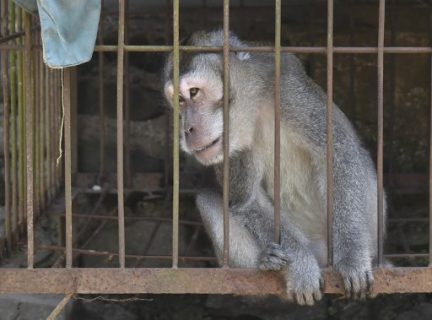
/ AFP /
by Yulius Martoni
Agence France Presse
KARANGASEM, Indonesia (AFP) — Volunteers are risking their lives to save tens of thousands of animals left at the mercy of a rumbling volcano on the tourist island of Bali, making perilous trips into the red zone to relocate them.
Mount Agung, about 75 kilometers (47 miles) from the resort hub of Kuta, has been shaking since August, causing some 144,000 people to evacuate their homes over the past week as experts warn an eruption could be imminent.
As evacuees have streamed into temporary shelters or moved in with relatives, animals — including wild monkeys as well as dogs and farm animals such as pigs, chickens and cows — have been left in the danger zone close to the volcano that is most at risk of cascading ash, rocks and hot gas.
“I’m really worried because all of us that work together to rescue the animals don’t know when the eruption will be,” Vio Verandhini, from Jakarta Animal Aid Network, told AFP.
“Earthquakes happen everyday, maybe every hour.”
There are hundreds of tremors each day triggered by the volcano, a handful of which are magnitude 2-3 and are strong enough to rattle windows and rock furniture.
Verandhini’s organization and several others have formed a 12-person emergency response unit that has been making dangerous trips into the red zone, which extends between nine and 12 kilometers from the mountain’s summit.
The animals are relocated to shelters where they are fed and cared for and the owners are encouraged to visit as often as possible to ensure their upkeep.
Livelihood at stake
The Indonesian Center for Volcanology and Geological Hazard Mitigation said Friday that remote satellite sensing had picked up new steam emissions and thermal areas within the crater.
White steam clouds above the summit have been observed with greater frequency over the past three days, increasing the probability of an eruption, the center said.
The slopes of Mount Agung are a hub for cattle farming in the region, providing an important source of income for local communities.
Around 10,000 cows have been shifted so far in an evacuation aided by the government, Indonesia’s disaster mitigation agency said, but there are 20,000 more to relocate.
The coordinator of a government livestock rescue team, Natakusuma, who goes by one name, said some farmers were sleeping at evacuation centers but returning to tend to their cattle during the day.
“Emotionally, it’s really hard for the farmers to part with their cattle, not only for economic reasons but also they care so much about the animals,” he said.
“Some insisted they stay in their village with their livestock even though their safety in is danger.”
Natakusuma said the government was trying to persuade farmers not to return by assuring them their livestock would be safe at special shelters.
Running out of space
Some forced to flee have carried their animals with them, fearful they will die or be stolen.
At a sports center packed with evacuees in Klungkung district, Ketut Pageh cradled one of the two roosters he saved before leaving home.
“I feel sorry for them, I took them so they won’t starve because there’s no one at home to feed them,” the 42-year-old said, adding he had to sell his pigs before fleeing.
Another evacuee, Nyoman Suwarta, tearfully recounted how he was separated from his two pet zebra doves amid the frantic rush to flee the volcano.
“When I was evacuating that night, I forgot to bring them with me,” said 52-year-old Suwarta, who was able to retrieve his birds nearly a week later.
“I feel very sorry for my birds because they have not been eating for six days.”
Faced with uncertainty about when — or if — the mountain will erupt, animal welfare groups are calling for feed, cages, water tanks and other supplies.
Verandhini said space to house the animals was becoming one of the most pressing issues.
“At the moment we have enough (room) but if a lot of people contact us, we should need more space for cows and dogs. We are still preparing for that,” she said.
© Agence France-Presse







